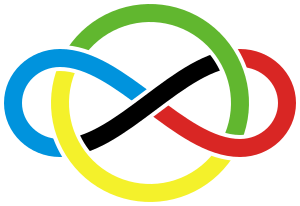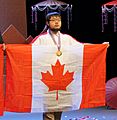International Mathematical Olympiad facts for kids
The International Mathematical Olympiad (IMO) is a big math competition for students who haven't started college yet. It's the oldest of the International Science Olympiads and is known as the most important math contest in the world. The first IMO happened in Romania in 1959. Since then, it has been held every year, except for 1980. More than 100 countries take part. Each country sends a team of up to six students. They also send a team leader, a deputy leader, and other helpers.
About half of the students who compete get awards. These awards are for individual students, not for teams. However, people often compare how well countries do as a team, even though it's not official.
Contents
- What Kinds of Math Problems Are There?
- How Students Are Chosen
- A Look Back at IMO History
- How Scoring Works
- How Countries Choose Their Teams
- Awards and Medals
- Rules and Disqualifications
- National Achievements
- Individual Achievements
- Gender Differences and the European Girls' Mathematical Olympiad
- IMO in the Media
- See also
- Images for kids
What Kinds of Math Problems Are There?
The problems in the IMO can be very hard. They cover topics like algebra and pre-calculus. They also include math areas not usually taught in high school or even college. These can be projective and complex geometry, functional equations, combinatorics, and number theory. You need to know a lot of math rules for these.
Even though you can use calculus to solve problems, it's never required. The idea is that anyone with basic math knowledge should understand the problems. The solutions, however, need much more skill. This helps make the competition fair for everyone. It also encourages finding clever and simple-looking problems that still need a lot of smart thinking to solve.
How Students Are Chosen
The way students are chosen for the IMO is different in each country. Often, it involves a series of tests. Fewer students are chosen after each test. To compete, students must be under 20 years old. They also cannot be enrolled in any college or university. If they meet these rules, a student can take part in the IMO many times.
A Look Back at IMO History
The first IMO took place in Romania in 1959. It has happened every year since then, except in 1980. That year, it was canceled because of problems in Mongolia. The competition first started for countries in Eastern Europe. Later, other countries joined in. Because of this, the first IMOs were only held in Eastern European countries. Over time, they started to be held in other nations too.
There are some differences in records about where early IMOs were held. This might be because leaders and students stayed in different places. Also, after the competition, students sometimes visited many cities. The exact dates can also vary. This is because leaders arrive before students, and the IMO Advisory Board arrives even earlier.
Many students have done very well in the IMO. Some, like Lisa Sauermann, Peter Scholze, Reid W. Barton, and Ciprian Manolescu, have won many gold medals. Others, such as Terence Tao, Artur Avila, Grigori Perelman, Ngô Bảo Châu, Peter Scholze and Maryam Mirzakhani, became famous mathematicians. Several past participants have won important awards, like the Fields Medal.
In 2016, after the IMO in Hong Kong, a young math talent from North Korea, Ri Jong-yol, sought safety at the South Korean consulate. He stayed there for two months. Chinese officials eventually let him fly to Seoul. He later became a South Korean citizen and changed his name to Lee Jung-ho. This is the only time something like this has happened in the IMO's history.
How Scoring Works
The competition has 6 math problems. It takes place over two days. Each day, students have four and a half hours to solve three problems. Each problem is worth 7 points. The highest possible score is 42 points. Students are not allowed to use calculators. Protractors were also banned recently.
Unlike other science competitions, the IMO doesn't have a set list of topics. It also doesn't include any college-level math. The problems come from different areas of high school math. These include geometry, number theory, algebra, and combinatorics. They don't need knowledge of advanced math like calculus. Solutions are often simple, but the problems are usually tricky. IMO problems are designed to test creativity and quick problem-solving skills.
Each country, except the host country, can suggest problems. A special committee from the host country chooses a shorter list of problems. The team leaders arrive a few days before the students. They form the IMO jury. This jury makes all the official decisions for the contest. This includes choosing the six problems from the shortlist. The jury tries to arrange the problems by difficulty. Problems Q1, Q2, and Q3 are for the first day, getting harder. Problems Q4, Q5, and Q6 are for the second day, also getting harder. Team leaders see the problems before the students. They are kept separate and watched closely.
Each country's scores are agreed upon by their team leader, deputy leader, and special helpers from the host country. If there are disagreements, the chief helper or the jury makes the final decision.
How Countries Choose Their Teams
The way countries pick their IMO teams is very different. In some countries, especially in East Asia, students take several very hard tests. These tests are as difficult as the IMO itself. For example, students in China go through a special training camp. In other countries, like the United States, students take easier competitions that get harder over time. In the U.S., these tests include the American Mathematics Competitions, the American Invitational Mathematics Examination, and the United States of America Junior Mathematical Olympiad/United States of America Mathematical Olympiad. Each of these is a competition on its own. Students who score very high in the final team selection competition also attend a summer camp, similar to China's.
In countries that were part of the former Soviet Union and other Eastern European nations, teams used to be chosen years in advance. They would get special training just for the IMO. However, some countries have stopped using these methods.
Awards and Medals
Students are ranked based on their individual scores. Medals are given to the top students. A little less than half of all participants receive a medal. The scores needed for a gold, silver, or bronze medal are set so that the number of gold, silver, and bronze medals are roughly in a 1:2:3 ratio. Students who don't win a medal but score 7 points on at least one problem get an honorable mention.
Sometimes, special prizes are given for solutions that are very clever or show a good way to solve a problem more generally. This happened in 1995 and 2005. It was more common before the early 1980s. The special prize in 2005 went to Iurie Boreico from Moldova. He got it for his solution to Problem 3, which was a math problem with three variables.
The rule that says at most half the students win a medal is sometimes bent. This happens if sticking to the rule would make the total number of medals too far from half the number of students. This occurred in 2010, 2012, and 2013. In these cases, slightly more than half the students received a medal.
Rules and Disqualifications
North Korea was disqualified twice for cheating. This happened at the 32nd IMO in 1991 and again at the 51st IMO in 2010. However, the 2010 event was debated. There have been other cases of cheating where students were penalized, but these were not officially announced. For example, in 1993, one student was disqualified for bringing a book of formulas. Two other students received zero points on the second day's paper for bringing calculators.
Russia has not been able to participate in the Olympiad since 2022. This was a response to its actions in Ukraine. However, a small number of students (6) from Russia are allowed to compete and receive awards. They do so remotely, and their scores are not included in the unofficial team ranking. In March 2022, more than half of the IMO 2021 Jury members voted to support this decision.
In May 2025, over 700 mathematicians, including some who won the Fields Medal, asked the IMO Board to suspend Israel's membership for the 2025 IMO. They said this should happen for similar reasons as Russia's suspension. The letter also mentioned that Israeli authorities prevented Palestinian IMO team members from leaving their country for the 2024 IMO. The president of the IMO Board has not taken action. He said the Jury might decide during the 2025 IMO. However, the letter claims he stopped the Jury from discussing this issue during the 2024 IMO by using a new rule.
National Achievements
The following countries have had the highest team score in the competition:
- China, 25 times: in 1989, 1990, 1992, 1993, 1995, 1997, 1999 (tied), 2000–2002, 2004–2006, 2008–2011, 2013, 2014, 2019 (tied), 2020–2023, 2025;
- Russia (including the Soviet Union), 16 times: in 1963–1967, 1972–1974, 1976, 1979, 1984, 1986 (tied), 1988, 1991, 1999 (tied), 2007;
- United States, 9 times: in 1977, 1981, 1986 (tied), 1994, 2015, 2016, 2018, 2019 (tied), 2024;
- Hungary, 6 times: in 1961, 1962, 1969–1971, 1975;
- Romania, 5 times: in 1959, 1978, 1985, 1987, 1996;
- West Germany, twice: in 1982 and 1983;
- South Korea, twice: in 2012 and 2017;
- Bulgaria, once: in 2003;
- Iran, once: in 1998;
- East Germany, once: in 1968.
The following countries have had all their team members win gold medals:
- China, 16 times: in 1992, 1993, 1997, 2000–2002, 2004, 2006, 2009–2011, 2019, 2021–2023, 2025.
- United States, 4 times: in 1994, 2011, 2016, and 2019.
- South Korea, 3 times: in 2012, 2017, and 2019.
- Russia, twice: in 2002 and 2008.
- Bulgaria, once: in 2003.
Only three countries have had their entire team score perfectly in the IMO: the United States in 1994, China in 2022, and Luxembourg (with its one-member team) in 1981. The U.S. team's success was even mentioned in TIME Magazine. Hungary won the IMO in 1975 in a unique way. None of its eight team members won a gold medal (they got five silver and three bronze). The second-place team, East Germany, also didn't have any gold medal winners.
The top ten countries with the best results of all time are:
| Country | Appearances | Gold | Silver | Bronze | Honorable mentions |
|---|---|---|---|---|---|
| 39 | 185 | 37 | 6 | 0 | |
| 50 | 151 | 120 | 30 | 1 | |
| 30 | 106 | 62 | 12 | 0 | |
| 37 | 95 | 83 | 28 | 7 | |
| 64 | 88 | 174 | 116 | 10 | |
| 65 | 86 | 158 | 111 | 7 | |
| 29 | 77 | 67 | 45 | 0 | |
| 48 | 69 | 117 | 85 | 3 | |
| 65 | 57 | 130 | 121 | 15 | |
| 57 | 56 | 124 | 131 | 18 |
Individual Achievements
Many individuals have done very well and won many medals at the IMO. Zhuo Qun Song from Canada has won the most medals. He has five gold medals (including one perfect score in 2015) and one bronze medal. Reid W. Barton from the United States was the first person to win a gold medal four times (1998–2001). Barton is also one of only eight people to win the Putnam Fellow award four times.
Christian Reiher (Germany), Lisa Sauermann (Germany), Teodor von Burg (Serbia), Nipun Pitimanaaree (Thailand), and Luke Robitaille (United States) are the only other students to have won four gold medals. Reiher also won a bronze medal. Sauermann won a silver medal. Von Burg won a silver and a bronze medal. Pitimanaaree won a silver medal. Wolfgang Burmeister (East Germany), Martin Härterich (West Germany), Iurie Boreico (Moldova), and Lim Jeck (Singapore) are the only other students to win five medals with at least three of them being gold.
Ciprian Manolescu from Romania achieved a perfect score (42 points) for a gold medal more times than anyone else. He did it all three times he competed in the IMO (1995, 1996, 1997). Manolescu also won the Putnam Fellow award three times. Eugenia Malinnikova from the Soviet Union is the highest-scoring female contestant in IMO history. She won 3 gold medals in 1989 (41 points), 1990 (42 points), and 1991 (42 points). She only missed one point in 1989, just short of Manolescu's record.
Terence Tao from Australia competed in the IMO in 1986, 1987, and 1988. He won bronze, silver, and gold medals, respectively. He won a gold medal when he was just thirteen in 1988. This made him the youngest person to win a gold medal. Zhuo Qun Song from Canada also won a gold medal at age 13 in 2011, but he was a bit older than Tao. Tao is also the youngest medalist ever, winning a bronze in 1986. Raúl Chávez Sarmiento from Peru is the second youngest, winning a bronze in 2009 at age 11. Representing the United States, Noam Elkies won a gold medal with a perfect score at age 14 in 1981. Both Elkies and Tao could have competed in the IMO many more times after their success. However, they started university, which made them no longer eligible.
Gender Differences and the European Girls' Mathematical Olympiad
Over the years, the IMO has had many more male contestants than female contestants. From 2000 to 2021, only 1,102 (9.2%) of the 11,950 contestants were female. The difference is even bigger for gold medal winners. From 1959 to 2021, there were 43 female (3.3%) and 1295 male gold medal winners.
This difference in participation and performance led to the creation of the European Girls' Mathematical Olympiad (EGMO).
IMO in the Media
- A documentary called "Hard Problems: The Road To The World's Toughest Math Contest" was made about the United States 2006 IMO team.
- A BBC documentary titled Beautiful Young Minds aired in July 2007. It was about the IMO.
- A BBC movie called X+Y was released in September 2014. It tells the story of an autistic boy who took part in the Olympiad.
- A book named Countdown by Steve Olson tells the story of the United States team's success in the 2001 Olympiad.
See also
 In Spanish: Olimpiada Internacional de Matemática para niños
In Spanish: Olimpiada Internacional de Matemática para niños
- List of International Mathematical Olympiads
- International Mathematics Competition for University Students (IMC)
- International Science Olympiad
- List of mathematics competitions
- Pan-African Mathematics Olympiads
- Junior Science Talent Search Examination
- Art of Problem Solving
- Mathcounts
Images for kids
-
Maryam Mirzakhani (Iran), the first woman to be honored with a Fields Medal, won 2 gold medals in 1994 and 1995, getting a perfect score in the second year.










